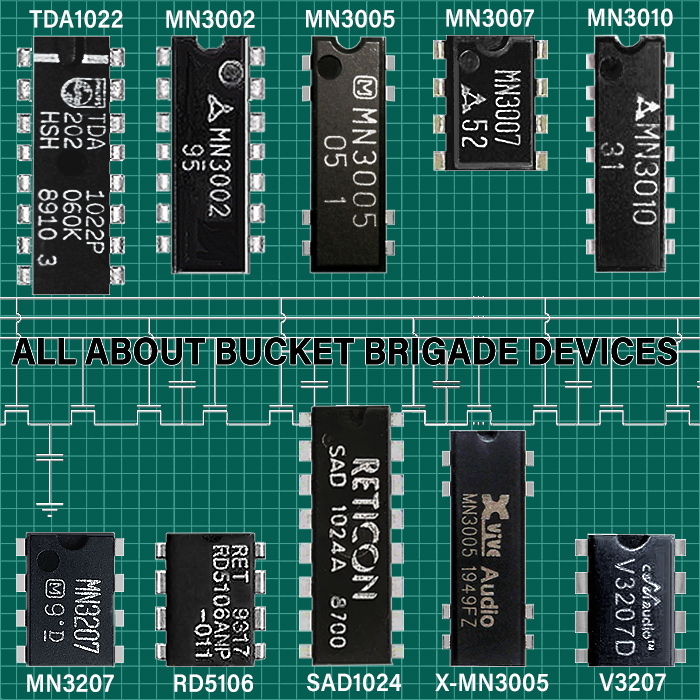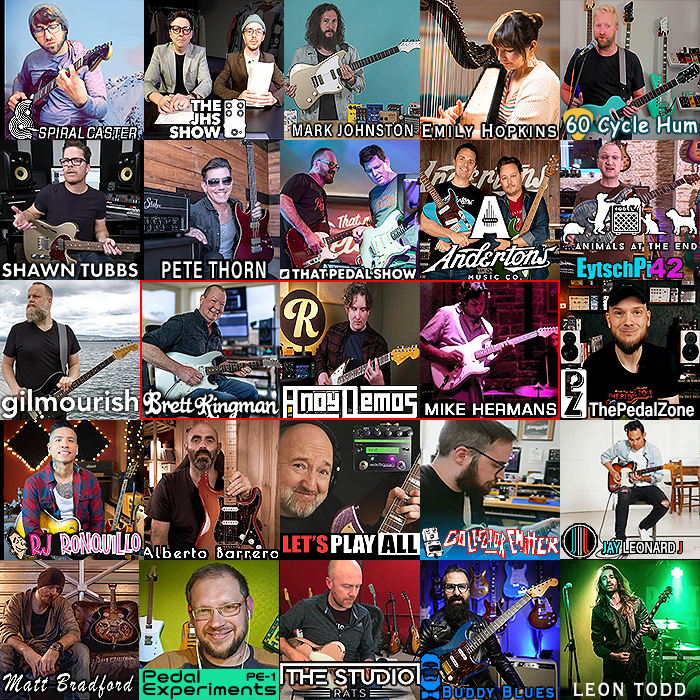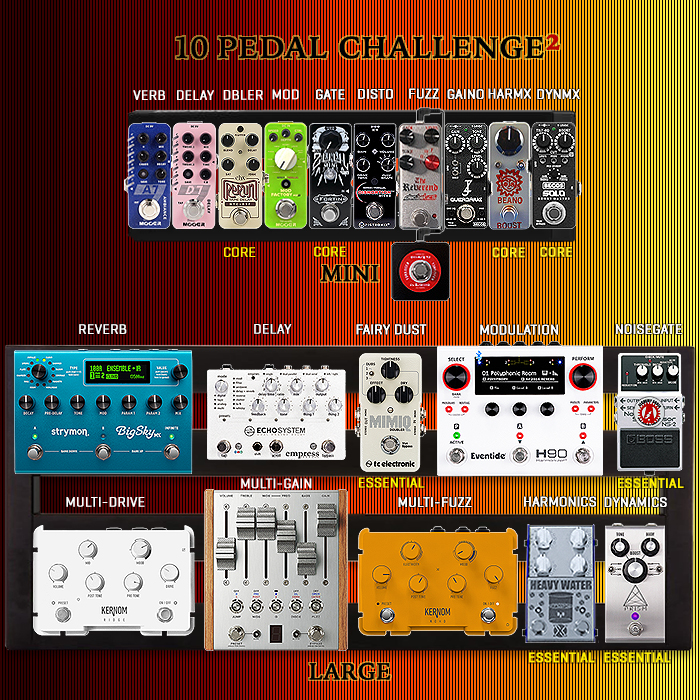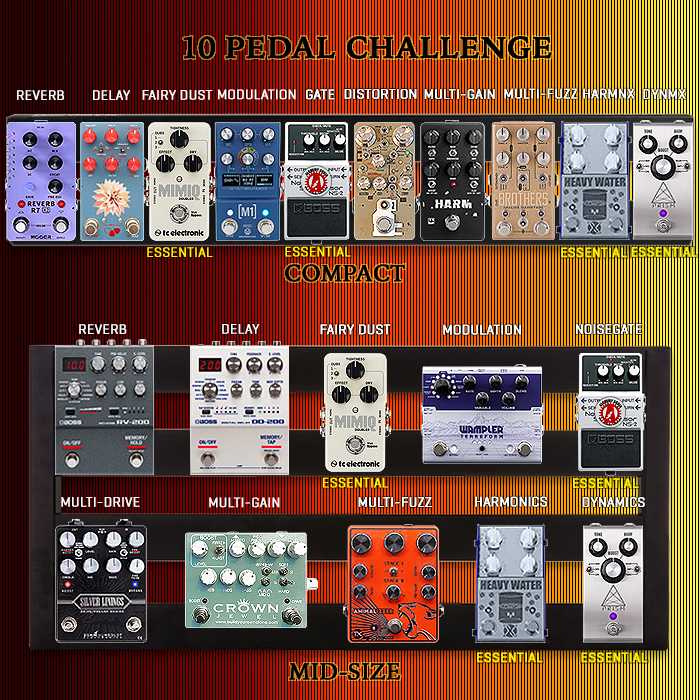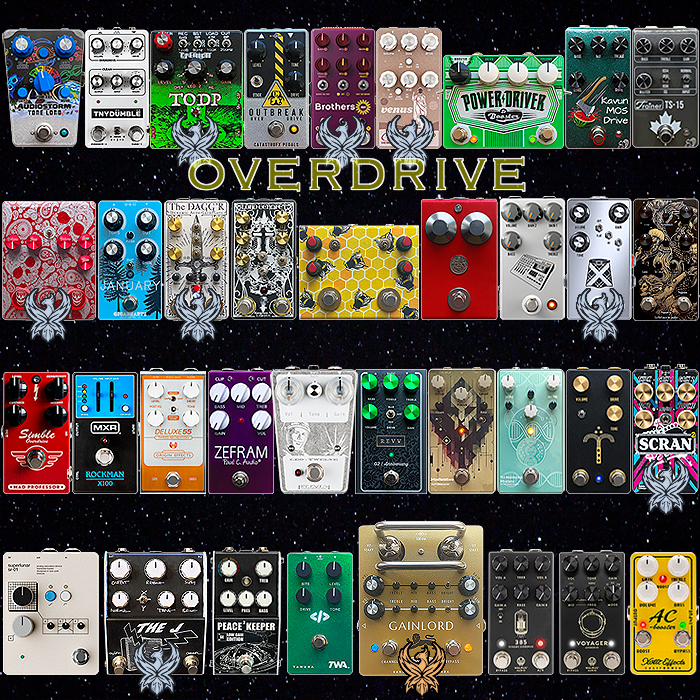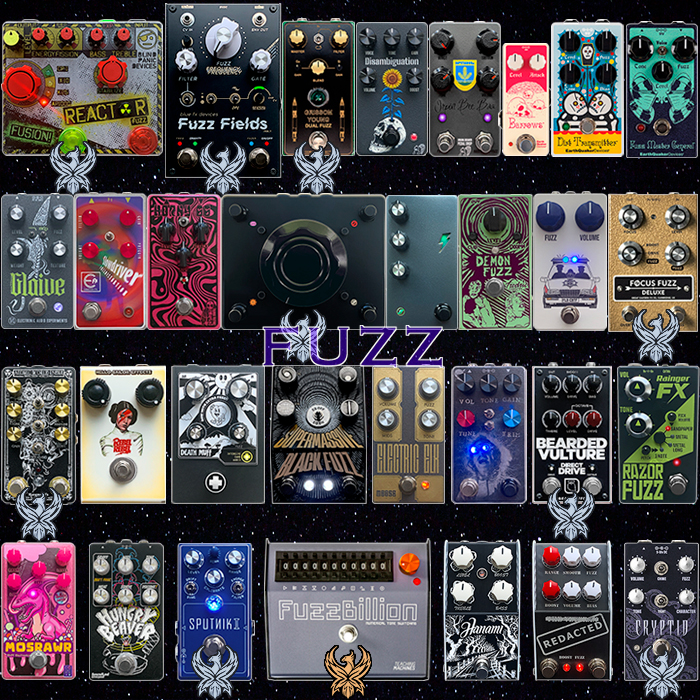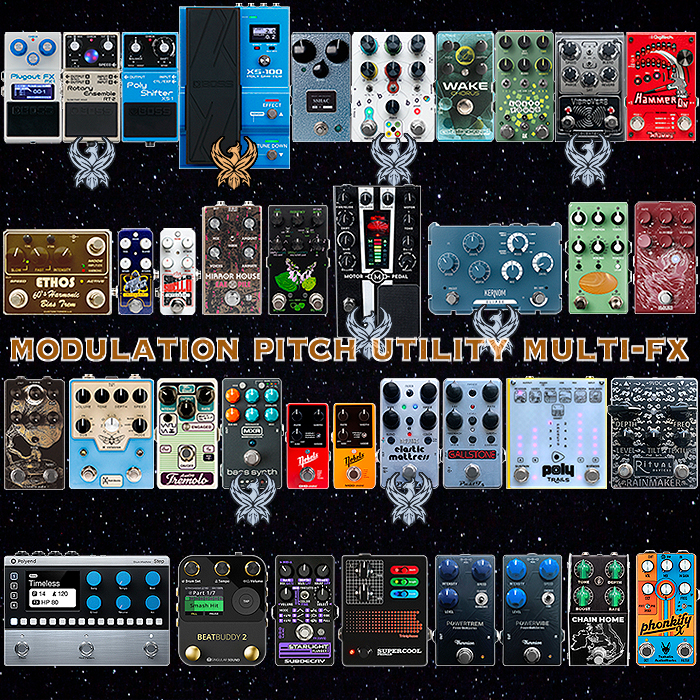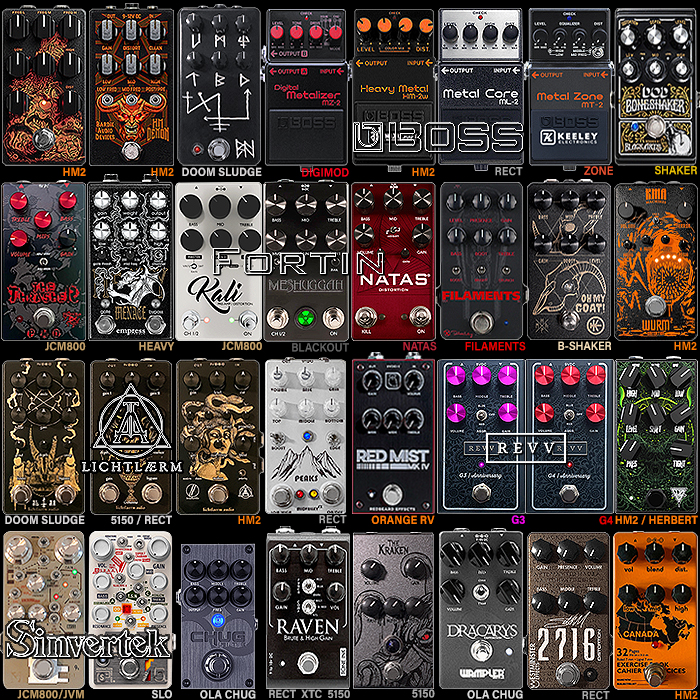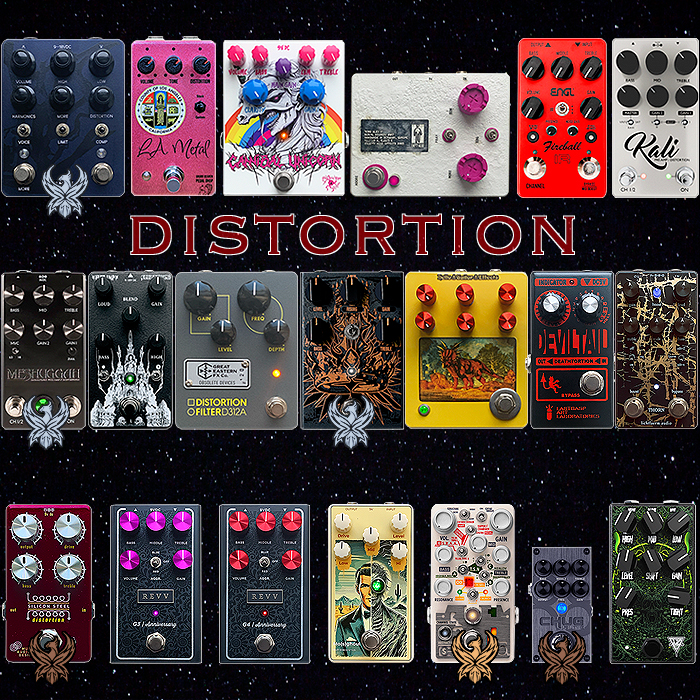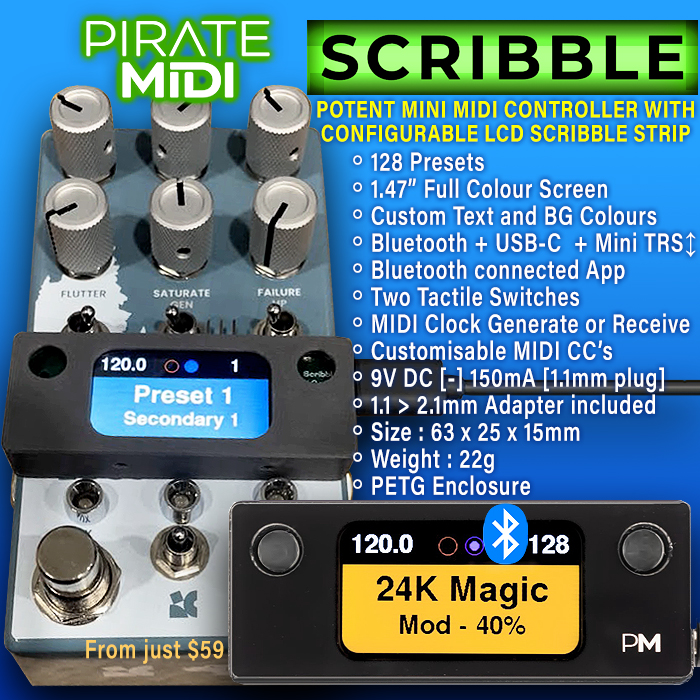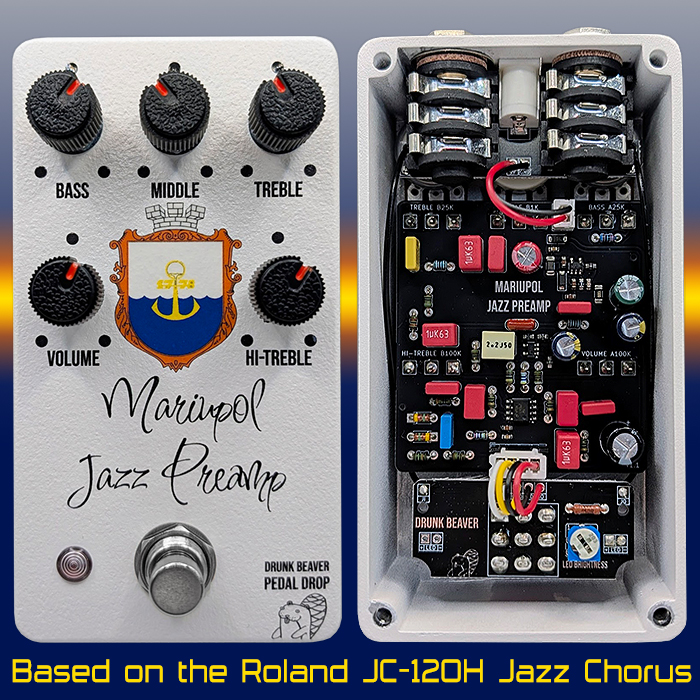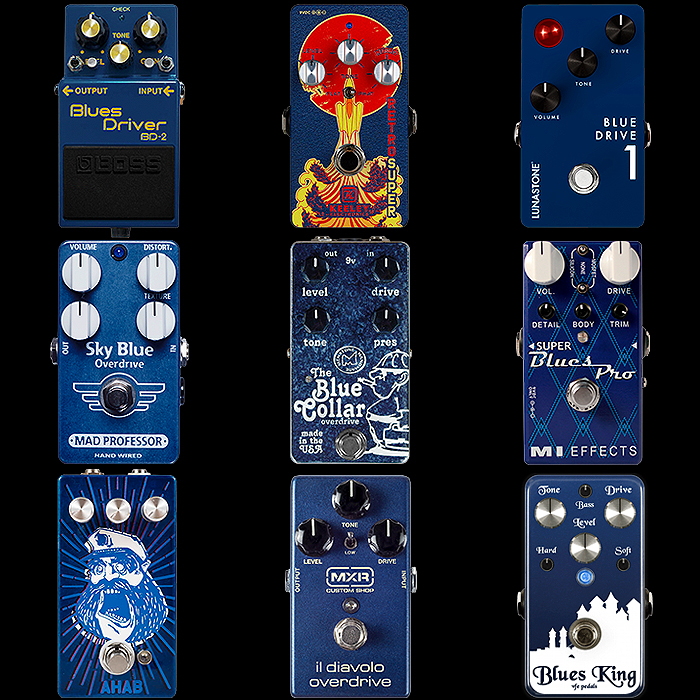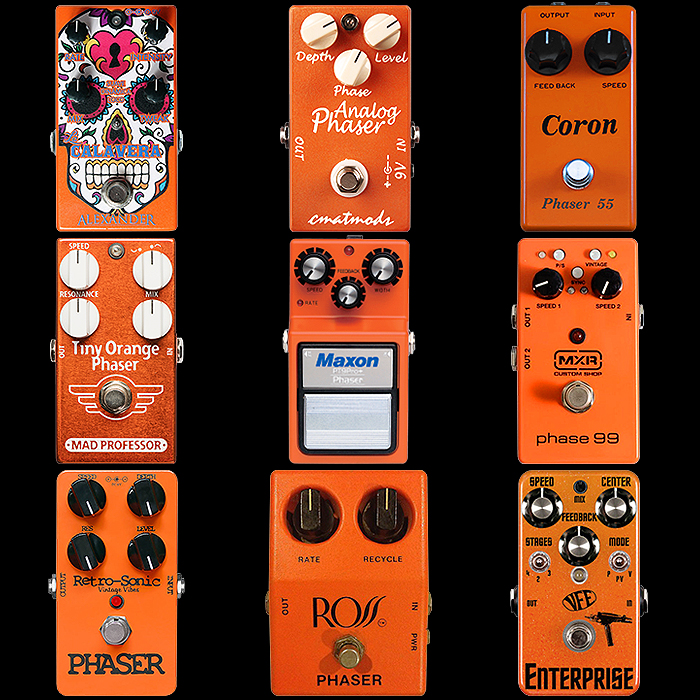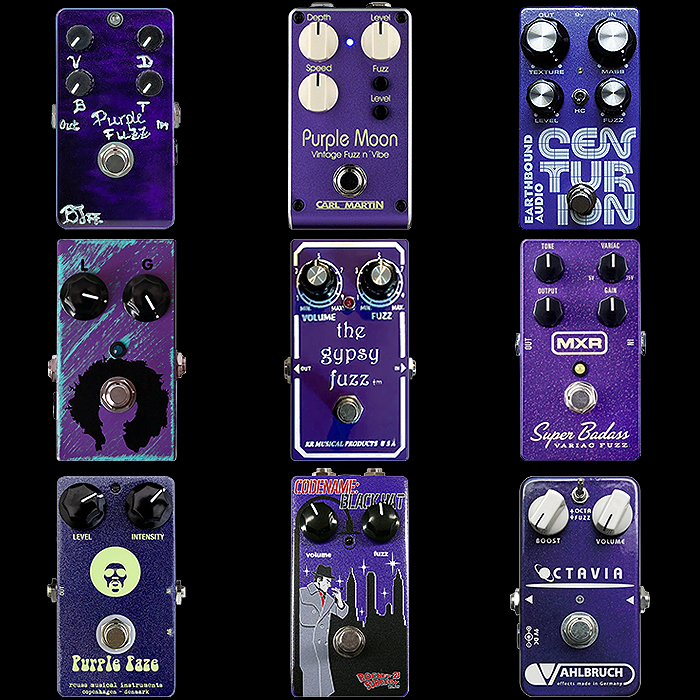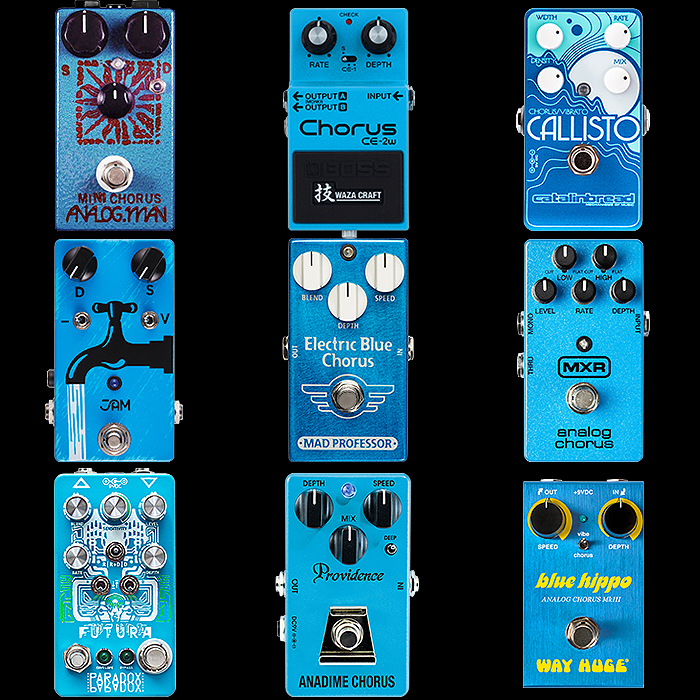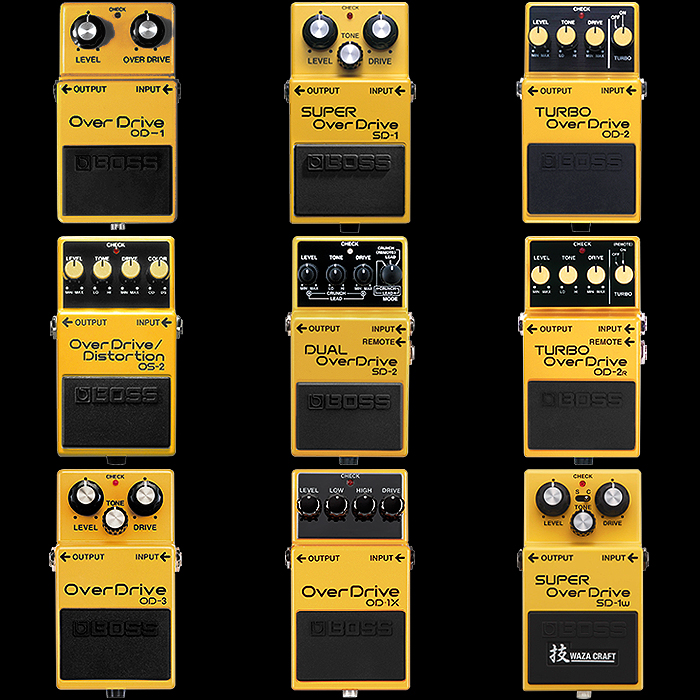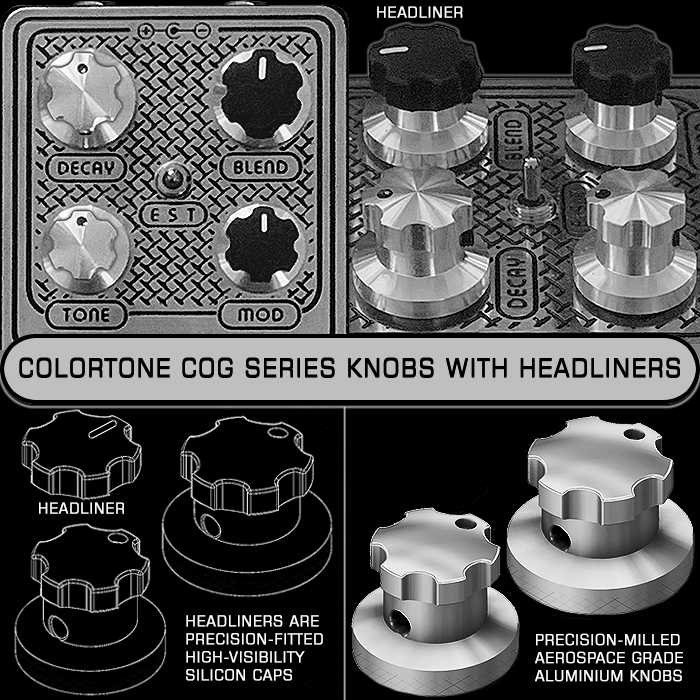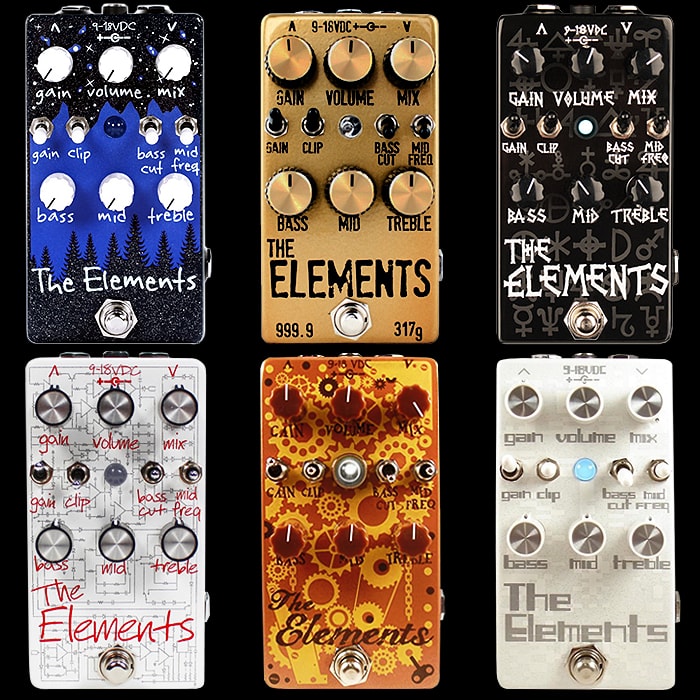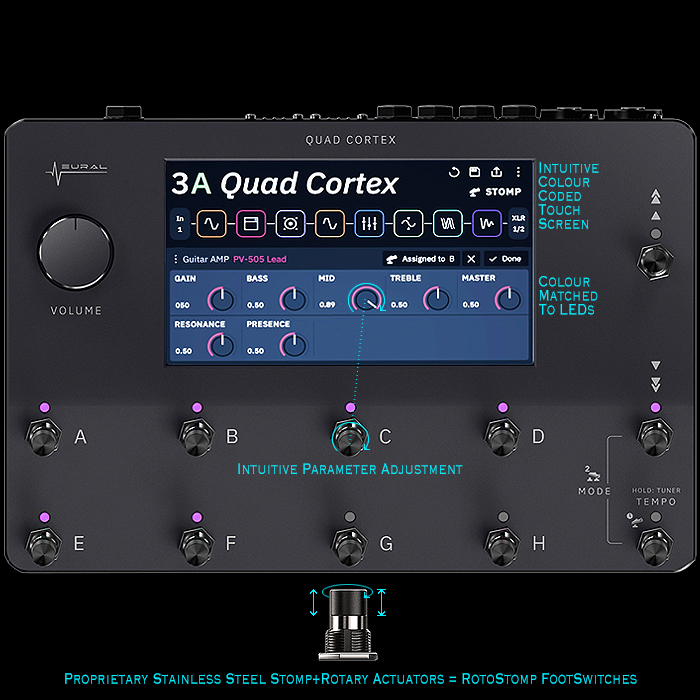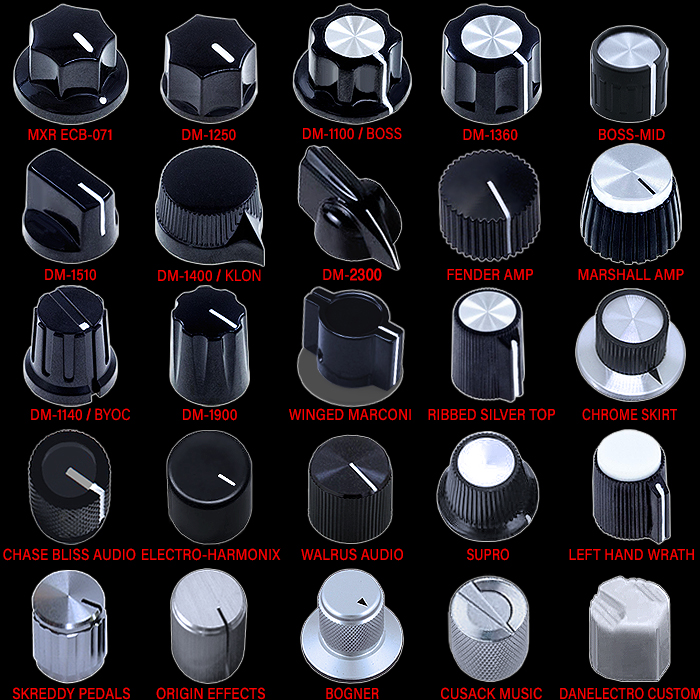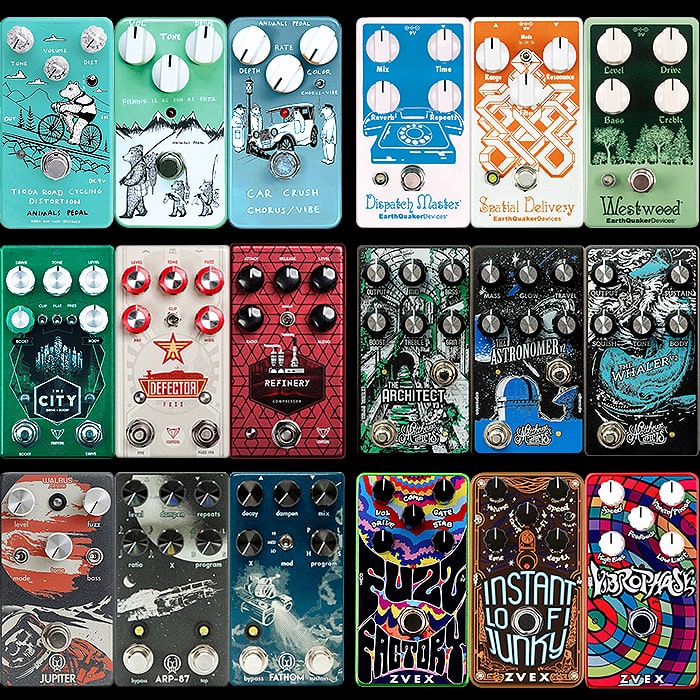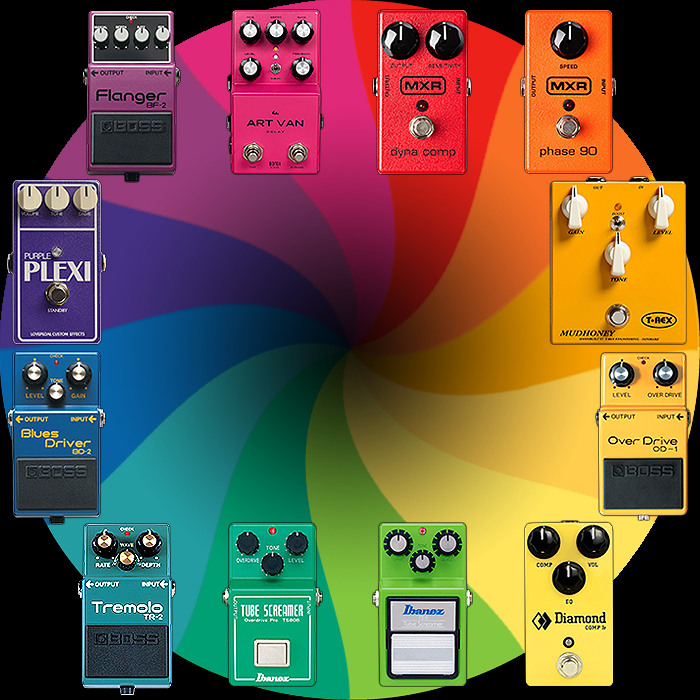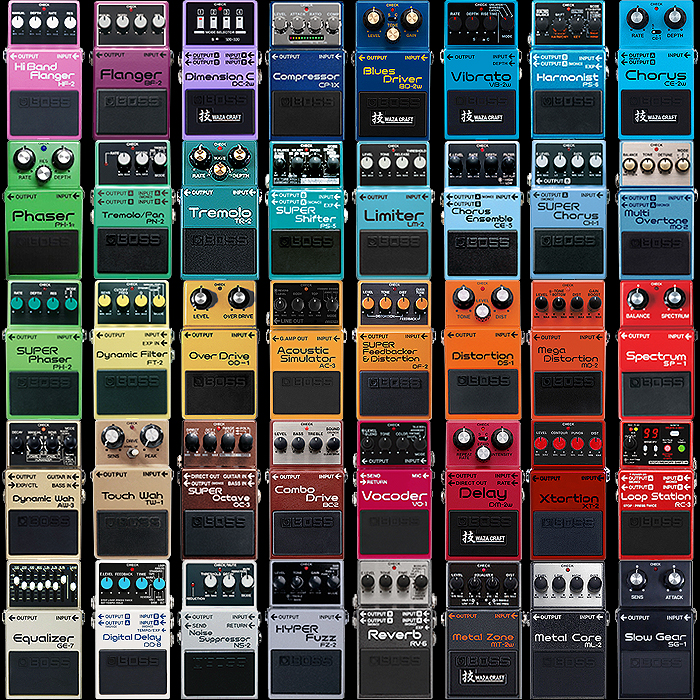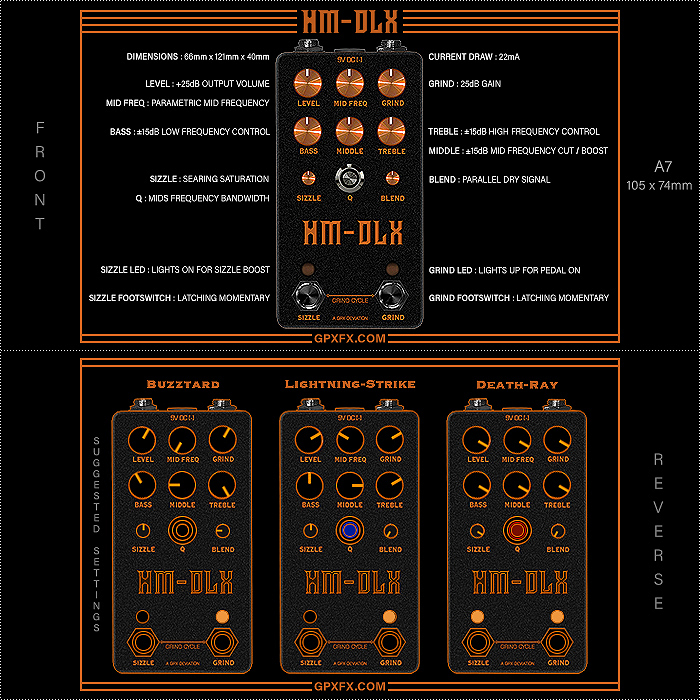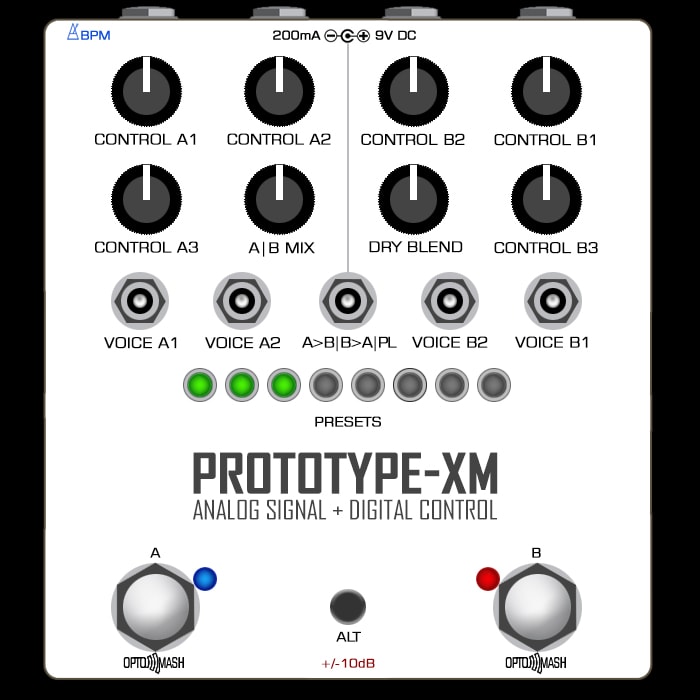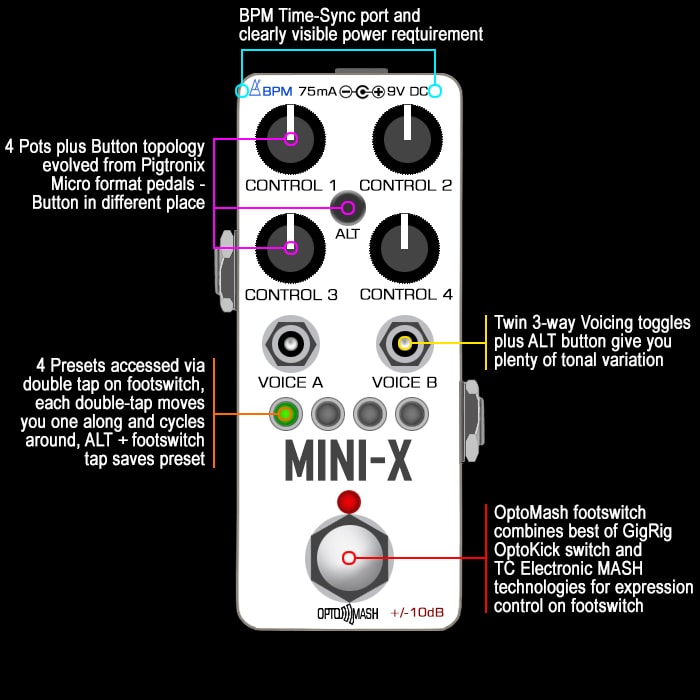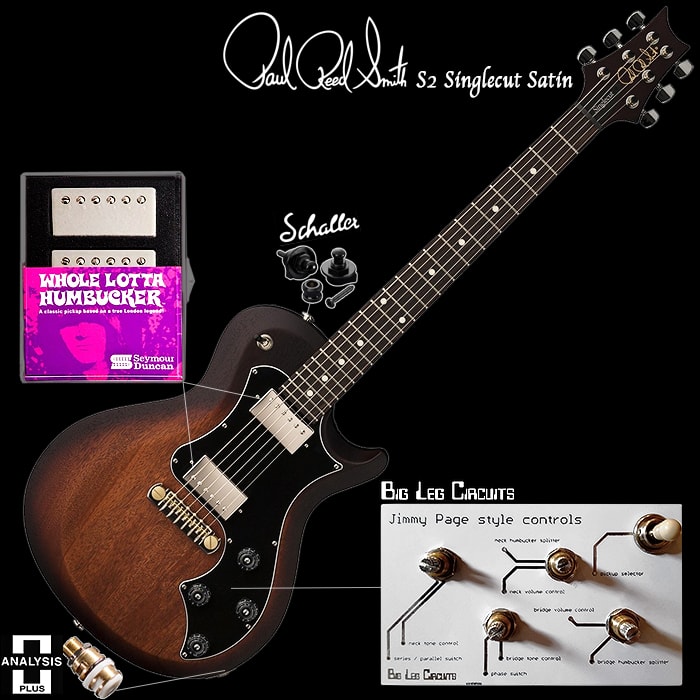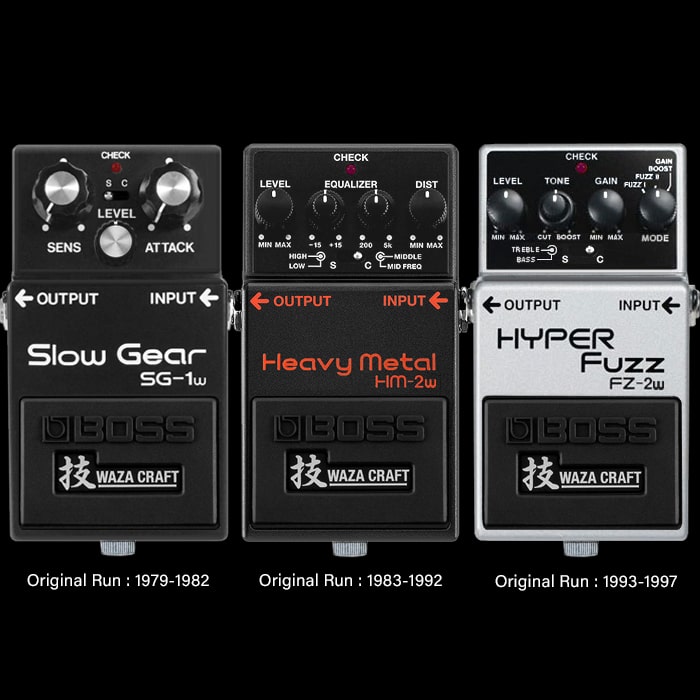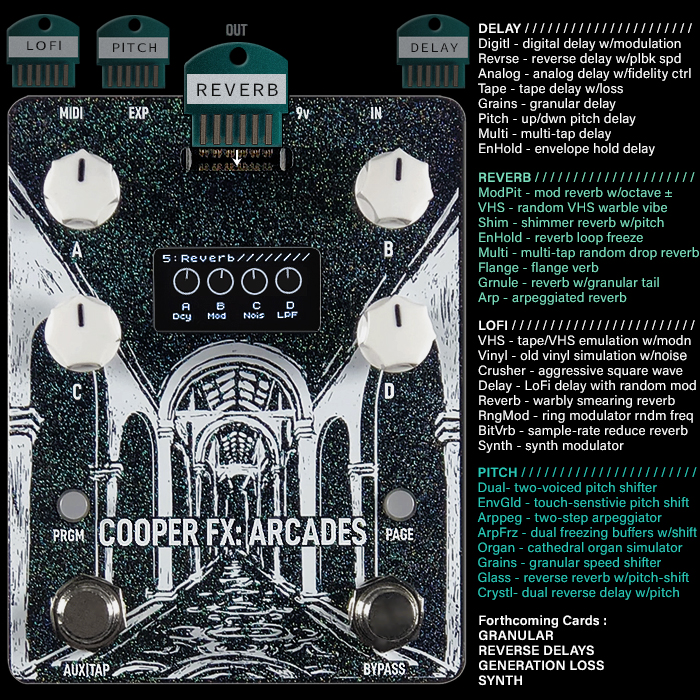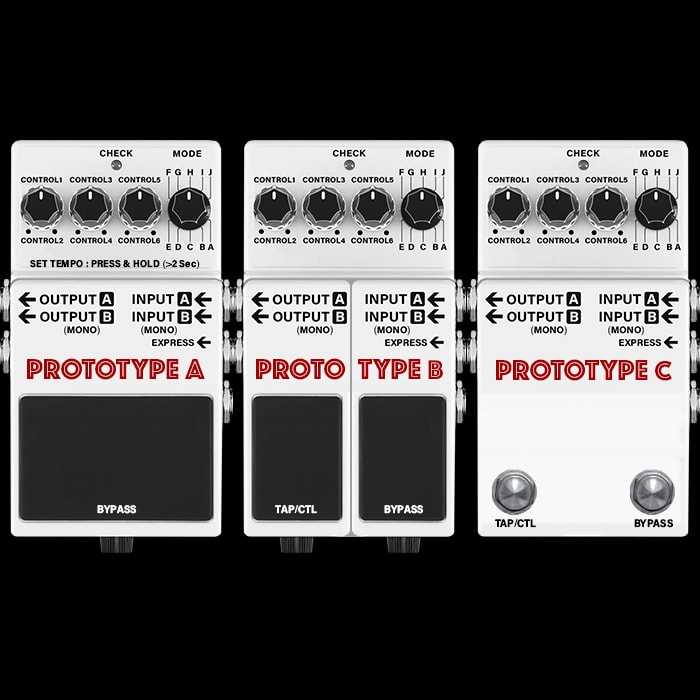The Perfect Compact Guitar Pedal Design - 2020 Edition
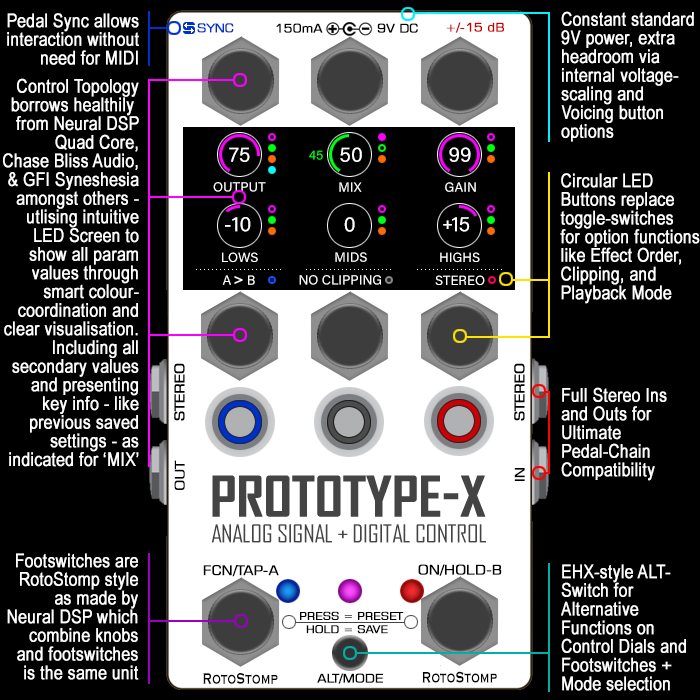
Readers of this blog will know that I periodically assemble and consider all the latest pedal technologies and interface innovations to produce a sort of extrapolated idealised composite for how compact pedal design might be improved/evolved.
I am constantly looking for more versatility and flexibility - as well as much improved usability and learnability - and more elegant ways to control and display secondary and advanced functions and scroll and activate presets. My very first take on the format was essentially an extension of the classic Chase Bliss Audio compact form factor - with the key change being the number of presets - and how those could be accessed via footswitches. An increasing amount of pedals have presets onboard now - but they are often accessed in some manual fashion rather than being scrollable and selectable via footswitch.
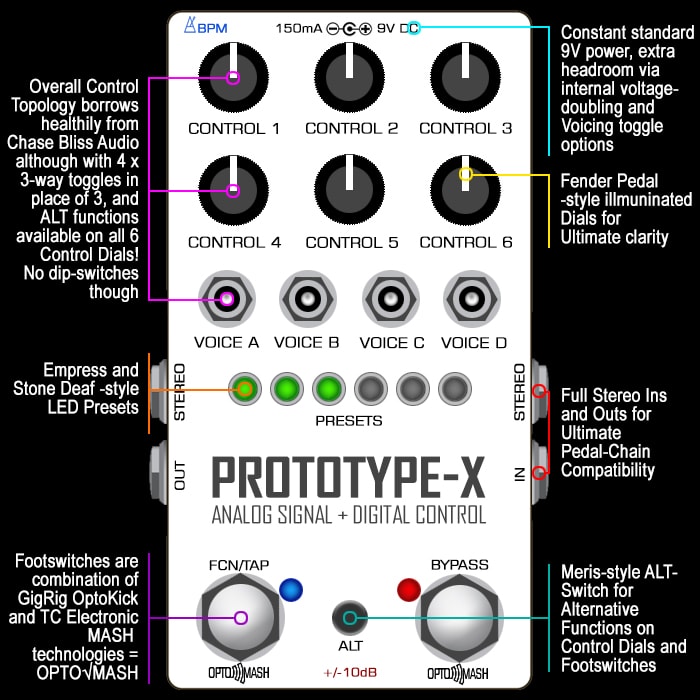
I've said before that an ideal method is to use the secondary footswitch - which is often primarily for tap-tempo or boost - but you then press-hold or double-tap if different function to switch to preset mode - to then be able to scroll through and select onboard presets. The new Boss 200 Series does this, as do the new Vs Audio pedals and several recently launched pedals - like the Keeley Eccos Stereo Flange-Modulated Delay. Other pedals work by using the dual footswitches in tandem tp scroll through presets - e.g. Stone Deaf FX Tremotron Tremolo and the recent Walrus Audio Mako D1 Stereo Delay. Either of these systems are perfectly fine - and should be the sort of de-facto standard - versus say the Source Audio Ventris where you have up to 8 onboard presets - but scroll through those via manual button push rather than footswitch manipulation.
My second take on the perfect pedal format (as below) took further cues from the then recently announced Chase Bliss Audio Automatone PreAmp MKII - where I added a small screen - similar to that found on Boss 200 Series pedals actually - so fairly low-resolution. I also tried to figure out a better way for displaying parameter values - particularly in light of secondary/advanced/alternative functions. I have always had an issue with how this mostly works currently - i.e. you hold down some Alt/Mode/Footswitch switch and then manipulate the same principal dials for secondary settings - but then have to return the dials back to the previous approximate position for the Primary parameters - so you can be fully up-to-date and cognisant with what's going on. Those pedals often use LEDs as visual cues to indicate when you hit the same saved secondary values on the dials - but it involves a sort of radio-tuning style of exercise - which is inefficient - and with more sensitive pedals - often changes too significantly the actual parameter setting on your primary.

So I sought to somehow colour-code and display parameter values on the very knobs themselves - so you would / could always see the correct values - and did not have to shift the dials back from secondary to primary positions and vice-versa. This technology is an obvious extrapolation as it does not exist yet. Sure you already have really small LED screens out there - so this is technically possible - but no one has yet engineered a rotary control knob with built-in parameter display - so possibly a pipe-dream to a degree! The Take 2 pedal also swapped the traditional toggle-switches for the newer more elegant and operationally robust multi-colour LED ring push-button switches - which I first saw deployed on the CBA Automatone, but ended up also on the Blooper Bottomless Looper - and at least one more pedal I saw in the wild - which I forget exactly what it was or which brand. But the proliferation has started!
And so onto the newest prototype - the MKIII as it were - which now takes significant cues from the forthcoming Neural DSP Quad Cortex, but also some from the forthcoming Electro-Harmonix Oceans 12 Stereo Dual Reverb and some input from the excellent GFI System Syneshesia. The latest innovations can be broken down into 3 main categories - Switches/Controllers, Display and Secondary Functions :
Use of Neural DSP 'RotoStomp' combined Footswitches and Rotary Encoders

One of the key innovations on the forthcoming Neural DSP Quad Core is the use of an entirely new type of footswitch - which ingeniously combines / builds in rotary actuators / encoders into the core stomp switches. Meaning that every footswitch now doubles up as a parameter controller. So every footswitch is now a knob and vice-versa - and you can use your default footswitches as control knobs / trim pots - meaning you remove the need to have to rely on internal controls. In my conversations with other builders - a key concern here is on durability and longevity - but if engineered in the right manner - there is no reason to believe this cannot be a suitably robust update to existing footswitches. On the Quad Core this if of course used to great effect in tandem with its intuitive display screen - while the nature of the footswitch + rotary encoders means that you can get away with using far less controllers on a typical pedal - or conversely get out far more possibilities.
Taking cues from the GFI Synesthesia also - each 'RotoStomp' controoller can feature 4 vectors of control:
- Turn
- Quick Press then Turn
- Long Press then Turn
- Press/Hold and Twist simultaneously
The above enhanced vectors of controls give you shortcut access to functions - such as tweaking secondary control values and the like - while some of those vectors can be accessed via other means. This is both about making the pedals simpler to use, but also to get further finesse out of the controls.
Use of Smart Intuitive Colour-Coded Always-on Display
The genius of the Neural DSP Quad Core is not just the new switches - but how the pedal communicates the parameter settings of those. It does so by visually representing each of the knobs on screen - with function labels and current values. The Quad Core also uses LEDs to further tie footswitches with control topology and parameters - while 'bar colours' as such on this pedal represent different layers of secondary functions - and tie into LED colour above ALT/MODE button - in a similar way to the EHX Oceans 12 q.v.
So on the display you see the actual current values for each of the dials - indicated via colour-coded bar-colours / intensity curves. You also see the values of the 3 push-button - which are used for more solidly selectable options - like effect routing, clipping options and playback modes.
In my visual you can see all lines/curves bar one are in magenta - those indicating primary parameters, while the MIX knob with green accent is indicating a secondary value. Each knob is accompanied by up to 4 colour dots - these indicate further functional states / alternative and secondary, tertiary and even quaternary values for each knob - each represented by a different colour and where you scroll through those layers as a whole using the ALT/MODE button, or individually by simply clicking on the appropriate knob - as is the case in our example.
A great cue from the GFI Synesthesia is 'Previous Stored Value' which you can see indicated for MIX to the left of the current display setting - as that knob has been accidentally nudged or deliberately changed - and you have proper reference to where you had it set previously.
The use of the display on the Quad Core is equally about mapping specific functions to control knobs - which change in number depending on settings profile accessed - while here the mapping is always tied to the 6 'RotoStomp' controllers and 3 LED-ring push-buttons.
More Intuitive Secondary Functions
Using the display in the above illustrated manner is obviously a combination of function-mapping and secondary level navigation. On most pedals the secondary functions are not labelled on the pedal - and you have to reference some sort of manual or crib-sheet to figure out what does what. The combination of Display Screen and RotoStomps here give you clear an accurate information at all times - and does away with the need to access further references.
As mentioned previously - we have the sort of EHX Oceans 12 inspired alt function button - which lights up when selected. In my example it lights up different colours - so by default would be Magenta which is what primary values are ascribed too, but you then click on it to view Secondary/Green parameters, once more to view Tertiary/Orange parameters and one final time before looping back to Magenta - to view Quaternary/Aqua parameters. So by pressing the ALT/MODE button the display changes to show secondary/tertiary/quaternary values as selected.
If you want to shift to secondary values on just a single controller you would short-press that to see the secondary value - which is what is indicated in the visual. You would not necessarily have more than 2 levels of control needed for each control knob - but you have the option to go 4 levels deep if necessary.
On all current pedals - including the exceptional GFI Synesthesia and various Meris and Strymon pedals - you need to alt-shift the control knobs to dial in secondary value - and then dial knobs back to again represent the proper primary value - which is a process riddled with inefficiencies and inaccuracies. It was high time we had a more elegant solution to this - and that is entirely what I'm proposing here.
Prototype Extrapolation
This if of course a visual Prototype - for sure grounded in technical actualities, possibilities and probabilities. Yet there are likely all manner of operational issues and considerations that might render this extrapolation impractical for manufacture - including cost of R&D, components, build, maintenance, longevity and reliability.
I am not expecting the whole industry to leap forward immediately and embrace this new paradigm - but to creatively borrow and utilise parts of this to improve core pedal function and usability. Versus what Mobile phones can do - the core guitar or effects pedal is actually very rudimentary - and there's plenty of scope for mechanical and technical innovation and improvement.
Not that not all makers will want to go down this route - or whether it will even make sense for many types of pedals. Core analog fuzz and dirt pedals can still be rendered very basically via traditional means - although the new RotoStomp switches would bring in some interesting new control and configurability possibilities - but you usually only need a handful of controls and no secondary values on those more simple pedals.
For newer pedals like the Keeley Eccos and Walrus Audio Mako D1 - where there are secondary functions - my above proposal is a much more intuitive and effective way to render those functions - and you don't need to keep re-setting the knobs back to original / previous positions.
Pedals have moved forward very significantly in these last few years and if anything the pace of innovation is still gathering speed. Based on what we have already seen - I expect most of the projected innovations to be in place in similar format within the next year or two - at least on certain types of pedals. We're seeing greater and greater functionality crammed into smaller and smaller form factor - but considering the state of evolution of the Mobile Phone - then the humble guitar effect pedal still has a long way to go.
I'm still fascinated by how few components are actually purpose developed and built for these devices. Historically the pedal/effects industry has been a by-product of other industries - where components were absorbed and adopted / adapted from different sectors. Near enough every valve, transistor, capacitor, resistor, OpAmp, chip etc was purpose-built for something else. So seeing things like Korg's NuTube and Neural DSP's 'RotoStomps' is very exciting indeed.
I imagine there are several out there that are resistant to change - while the pedal industry has always been about change right from the start. There is though a significant DIY factor to a lot of pedal-building - where a lot of those builders are not up-to-speed on digital controls and many / most probably never will be. For brands on the leading edge though - this is something they will need to consider to maintain market leadership. Of course people are always looking for easier and more effective / more efficient ways of doing things - and a lot of those control interfaces and routines are somewhat clunky and inadequate.
I noted in my final review of the Glitch Effects Sector last year - how difficult many of those pedals were to control - and how it marred the ownership and playback experience. Those multi-effects or multi-function pedals definitely need something along these lines to make them an easier proposition for consumers. Of course another challenge will be to achieve the right cost of manufacture. R&D and Prototyping is an expensive activity - and all those costs can make for a very expensive final product - which can limit its proliferation significantly. With consumer tech the magic figure has always been $100 - in that if you get a device out at that RRP it immediately opens up the mass-market. I'm not clear on exactly what the equivalent value is for effects pedals. The mean / aggregate value I pay for pedals is probably somewhere around $150-$200 overall - so possibly these innovations need to be made available at that level to be fully workable. The Neural DSP Quad Core goes on sale properly in September for a RRP of $1,600 - and I will be fascinated to see just how quickly some of those innovations take to seep into the mainstream!

